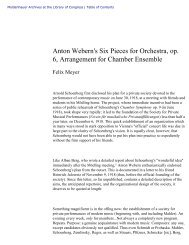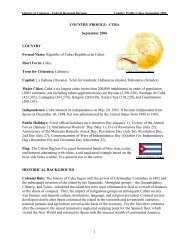1 - American Memory
1 - American Memory
1 - American Memory
Create successful ePaper yourself
Turn your PDF publications into a flip-book with our unique Google optimized e-Paper software.
243<br />
house" system Is not in operation. Irregular shipping schedules and the possi-<br />
bility of strikes discourage complete dependence on a continual flow of supplies<br />
from the mainland. Instead, Hawaiian businessmen hedge against possible short-<br />
ages by maintaining substantial and larger than mainland inventories. In the<br />
aggregate. Hawaiian firms maintain excessive inventories by mainland stand-<br />
ard.s—a supply one to two months above mainland inventories.<br />
Even on perishable and semi-perishable items, higher than mainland stocks<br />
are maintained. But in the interest of product quality and brand acceptance,<br />
there has been a tendency to reduce storage times on semi-perishable staples<br />
such as canned milk and rice because their quality does deteriorate with time,<br />
especially in Hawaii's semi-tropical climate. In times of strike threats, large<br />
stocks are built up even though they may not be desirable from a product qual-<br />
ity viewpoint. By extending liberal credit terms to Hawaiian businesses, main-<br />
land manufacturers encourage inventory buildups on semi-perishable items—up<br />
to 90 or more days supply—sometimes beyond the limit of perishability. This<br />
type of buildup in 1962 resulted in some food items having to be destroyed.<br />
Major manufacturers with well known brand names are willing to subsidise<br />
the buildup of stocks in order to keep their product in front of the consumer.<br />
Brand loyalty frequently follows from consistent and dependable service and<br />
high quality. This leads to repeat purchases and this "consumer franchise" is<br />
worth a considerable amount to these manufacturers. Some are willing to go to<br />
great lengths to protect It. One of the major cereal manufacturers, for example,<br />
flew in two plane loads of cereal at a cost of $30,000 during the 1962 strike, but<br />
before the "cooling-off' period (and lost money on every case). During the in-<br />
junction period this firm brought In an additional two months' supply and placed<br />
it in local warehouses. These and similar "old" stocks were still being worked off<br />
months later by several Arms because the strike was settled at the end of the<br />
injunction period.<br />
Higher Inventories Are Costly<br />
The earlier analysis of the cost of carrying inventory indicated that the higher<br />
inventories needed to hedge against delivery uncertainties probably add 3 to 5<br />
per cent to retail prices in Hawaii during normal times. In addition, the buildup<br />
of inventory before and during strikes can only add additional costs at the rate<br />
up to 2 per cent per month of added inventory—probably on an additional one<br />
to two months' supply. These added costs, of course, must be passed on to the<br />
consumer in higher prices. This is obvious as many wholesalers and retailers<br />
operate on a profit of only 1 to S per cent of sales and cannot assume any addi-<br />
tional cost.<br />
Stockpiling Cannot Keep the Economy Ooing<br />
The most damaging argument against the stockpiling approach is that not all<br />
of the items which are needed to keep an economy going can be stockpiled. A mod-<br />
em economy depends upon the ready availability of literally hundreds of thou-<br />
sands of items at widely varying rates of use. Unless an economy is completely<br />
self-suffldent. It must depend upon a continual exchange of commodities with the<br />
other parts of the system. To attemp to run any part of an economy without<br />
benefit of supplies from the other parts of the system Is completely unrealistic.<br />
Here, Hawaii is a part of the United States economic system and cannot exist for<br />
long without continual interaction with the rest of the system.<br />
Hawaii's insular position and almost complete dependence upon only one<br />
method of transportation and predominately one carrier is unique in the United<br />
States. All other states have access to several modes of transportation. In the<br />
extreme, if all common carriers were tied up with strikes, mainland firms could<br />
buy, rent, or lease their own trucks and assure a continual flow of supplies. This<br />
option is not open to Hawaiian firms.<br />
Additional Stockpiling Not Feasible or Tfecessary<br />
It appears that additional stockpiling is not needed at this time. Hawaiian<br />
businessmen already maintain large and higher than mainland stocks and are<br />
willing to, and do, add to these stocks substantially when they have adequate<br />
notice of strikes. In spite of these larger stocks, some items quickly become<br />
critically short. These are items which are relatively perishable and which would



![Albert Einstein Papers [finding aid]. Library of Congress. [PDF ...](https://img.yumpu.com/21604228/1/190x245/albert-einstein-papers-finding-aid-library-of-congress-pdf-.jpg?quality=85)





![American Colony in Jerusalem Collection [finding aid]. Library of ...](https://img.yumpu.com/17941275/1/190x245/american-colony-in-jerusalem-collection-finding-aid-library-of-.jpg?quality=85)



![Piccard Family Papers [finding aid]. - American Memory - Library of ...](https://img.yumpu.com/17941234/1/190x245/piccard-family-papers-finding-aid-american-memory-library-of-.jpg?quality=85)


